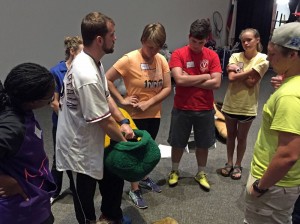It’s not easy to be an anthropomorphic wasp. Ditto a supersized pirate or a latter-day centurion.
To start with, do you even know where your eyes are? How about your ears? Or your tail?
Most humans don’t have tails, of course, but when you’re a sports team mascot, you’d better be aware of yours. That was just one of the lessons learned at the first-ever Rangers Captain Mascot Clinic. The event imparted tons of other information you might never have thought of unless you’d regularly donned a fake furry cranium and dashed around a sporting venue.
The Rangers held the event in their Hall of Fame’s theater this past Saturday. The team’s mascot coordinator, Tanner Leggett, created it to give high school and middle school mascots a chance to learn from a pro how to properly execute vital mascot tasks, like, um, being totally goofy.
Leggett brought me in as an instructor because of my background putting mascots in videos and working with Rangers Captain in live settings, but I learned more than I contributed. I may never have to suit up as a horse, lizard, or undefined mammalian, but if I do, I’ll be prepared. Some highlights:
It really is important to know where your character’s body parts are. Leggett had the eight students put on their heads and called out various actions like covering the eyes, washing the face, or brushing the teeth. Later, he had them walk through a maze he had built so to help them build awareness of their external appendages, like tails or oversized feet. When you have tiny children sneaking up on you, it’s imperative you know what’s flapping where.
Need to keep your cap on while performing? Earth magnets and metal plates hold Captain’s headgear in place. He always uses at least two magnets so the cap doesn’t spin.
Did you ever notice that Rangers Captain wears wrist bands? They help keep his gloves in place,
There’s even a proper technique for using your oversized mouth to bite a child’s head, and a chin strap is apparently indispensable.
One area on which the group spent a lot of time involved suit maintenance. An aspiring mascot should learn basic sewing skills to prevent a small rip from becoming an embarrassing one. One of the most crucial aspects of mascotting involves keeping one’s attire clean and tidy. Without exception, costumes get steamy, especially in Texas. Perspiration can make an outfit smell less than pleasant, so Rangers Captain washes his after every game. We learned one can use shaving cream to help cleanse mascot heads and to never put fur in the dryer.
We also discovered from the attendees that cheerleaders apparently have a reputation for stealing safety pins (a mascot must-have). Cut that out, cheer squad!
Along with costume upkeep, attendees learned about keeping their own bodies fit, too. Leggett and colleague Genifer Oliver delivered insight about stretching, eating, and, of course, drinking sufficient amounts of water.
Leggett put plenty of work into performance, too. Non-verbal improvisational comedy exercises helped the students hone their comedic communication skills. A big part of the curriculum involved understanding the character itself. Personages should have reasons for reacting certain ways, and that can involve advance planning. Leggett encouraged the students to create backstories for their alter egos, ones that could survive their own scholastic careers. He also directed them to remain mindful of the permanent facial expression etched into each costume’s head when acting.
No mascot works in a vacuum (not even a space alien). We discussed the job of a mascot handler or co-host. Every costumed performer has a horror story involving an overaggressive, under-supervised child and a proper assistant can keep the character brat-free.
The day concluded with a skit competition. Sparty the Spartan (aka Sydney Aalbers) won and will get a chance to perform at a Rangers game with Rangers Captain later this season.
The mascots skewed male, though the performers themselves were an equal number of boys and girls. The attendees came from around the area and Champ the Charger cantered all the way from Midland. Each one left with a goodie bag, an extensive how-to manual, and insight I’m frankly not sure he or she could have gotten anywhere else in North Texas – knowledge about important stuff, like, you know, spraying silly string for Stan Lee’s benefit or tweaking Mike Trout.
Disclosure : The Rangers paid me to teach the event’s attendees about marketing and related aspects of the mascot business.



















